Adaptable Hybrid Beamforming with Subset Optimization Algorithm for Multi-User Massive MIMO Systems
Abstract
:1. Introduction
- Firstly, we propose a subset optimization algorithm-based hybrid beamforming (SOA-HBF) scheme for implementing adaptive HBF in massive MIMO systems. The SOA-HBF effectively reduces inter-user interference and improves system sum rate by dividing the users set into subsets based on inter-user correlation. Analog beamformers are pre-selected from the codebook for each subset, and the corresponding digital beamformer is computed using the RZF precoding algorithm. This method balances computational complexity and performance by sequentially removing selected vectors from the codebook, ensuring optimized analog precoding.
- Secondly, to demonstrate the effectiveness and adaptability of the proposed scheme, we evaluate it in a typical mmWave massive MIMO system without obstacles. This scenario assesses the performance in a straightforward communication environment, highlighting the proposed scheme’s capability. To further illustrate the adaptability of the scheme, we introduce an IRS-assisted massive MIMO system for scenarios with obstacles. The IRS is employed to mitigate the impact of obstacles and reconfigure the wireless propagation environment. Specifically, the IRS-assisted system is modeled using the traditional Rician channel to simulate the links between the BS, IRS, and the users set. This dual evaluation not only shows the performance of SOA-HBF in an ideal mmWave environment but also demonstrates the scheme’s capability to adapt to and enhance communication quality in more complex, obstacle-laden environments.
- Finally, extensive simulation experiments are conducted to validate the proposed scheme. By varying SNR and controlling other variables, we analyze the system’s performance across different scenarios. The results show that the SOA-HBF scheme significantly outperforms some existing HBF schemes, demonstrating strong adaptability and effectiveness in both obstacle-free and IRS-assisted communication environments. This confirms the scheme’s capability to enhance system’s capacity and reliability.
2. System Model and Problem Formulation
2.1. System Model
2.2. Problem Formulation
3. An HBF Scheme Based on Subset Optimization Algorithm
3.1. First Stage of SOA
3.2. Second Stage of SOA
3.3. SOA-Based HBF Scheme SOA-HBF
| Algorithm 1 First Stage of SOA Algorithm |
|
| Algorithm 2 Second Stage of SOA Algorithm |
|
4. Simulation Results
4.1. Determination of RZF Regularization Factors
4.2. The Impact of Four Perspectives on IRS-Assisted System’s Sum Rate
4.3. The Impact of Three Perspectives on Traditional Direct Link System’s Sum Rate
5. Conclusions
Author Contributions
Funding
Institutional Review Board Statement
Informed Consent Statement
Data Availability Statement
Acknowledgments
Conflicts of Interest
References
- Alsharif, M.H.; Kelechi, A.H.; Kim, J.; Kim, J.H. Energy efficiency and coverage trade-off in 5G for eco-friendly and sustainable cellular networks. Symmetry 2019, 11, 408. [Google Scholar] [CrossRef]
- Shafi, M.; Molisch, A.F.; Smith, P.J.; Haustein, T.; Zhu, P.; De Silva, P.; Tufvesson, F.; Benjebbour, A.; Wunder, G. 5G: A tutorial overview of standards, trials, challenges, deployment, and practice. IEEE J. Sel. Areas Commun. 2017, 35, 1201–1221. [Google Scholar] [CrossRef]
- Wu, Q.; Xu, J.; Zeng, Y.; Ng, D.W.K.; Al-Dhahir, N.; Schober, R.; Swindlehurst, A.L. A comprehensive overview on 5G-and-beyond networks with UAVs: From communications to sensing and intelligence. IEEE J. Sel. Areas Commun. 2021, 39, 2912–2945. [Google Scholar] [CrossRef]
- Marzetta, T.L. Noncooperative cellular wireless with unlimited numbers of base station antennas. IEEE Trans. Wirel. Commun. 2010, 9, 3590–3600. [Google Scholar] [CrossRef]
- Chataut, R.; Akl, R. Massive MIMO systems for 5G and beyond networks—Overview, recent trends, challenges, and future research direction. Sensors 2020, 20, 2753. [Google Scholar] [CrossRef] [PubMed]
- Molisch, A.F.; Ratnam, V.V.; Han, S.; Li, Z.; Nguyen, S.L.H.; Li, L.; Haneda, K. Hybrid beamforming for massive MIMO: A survey. IEEE Commun. Mag. 2017, 55, 134–141. [Google Scholar] [CrossRef]
- Pang, X.; Zhao, N.; Tang, J.; Wu, C.; Niyato, D.; Wong, K.K. IRS-assisted secure UAV transmission via joint trajectory and beamforming design. IEEE Trans. Commun. 2021, 70, 1140–1152. [Google Scholar] [CrossRef]
- El Ayach, O.; Rajagopal, S.; Abu-Surra, S.; Pi, Z.; Heath, R.W. Spatially sparse precoding in millimeter wave MIMO systems. IEEE Trans. Wirel. Commun. 2014, 13, 1499–1513. [Google Scholar] [CrossRef]
- Tan, W.; Xie, D.; Xia, J.; Tan, W.; Fan, L.; Jin, S. Spectral and energy efficiency of massive MIMO for hybrid architectures based on phase shifters. IEEE Access 2018, 6, 11751–11759. [Google Scholar] [CrossRef]
- Ding, Y.; Hu, A. Grouping optimization based hybrid beamforming for multiuser mmWave massive MIMO systems. In Proceedings of the 2019 IEEE 2nd International Conference on Computer and Communication Engineering Technology (CCET), Beijing, China, 16–18 August 2019; pp. 203–207. [Google Scholar]
- Sheemar, C.K.; Thomas, C.K.; Slock, D. Practical hybrid beamforming for millimeter wave massive MIMO full duplex with limited dynamic range. IEEE Open J. Commun. Soc. 2022, 3, 127–143. [Google Scholar] [CrossRef]
- Fatema, N.; Hua, G.; Xiang, Y.; Peng, D.; Natgunanathan, I. Massive MIMO linear precoding: A survey. IEEE Syst. J. 2017, 12, 3920–3931. [Google Scholar] [CrossRef]
- Interdonato, G.; Karlsson, M.; Björnson, E.; Larsson, E.G. Local partial zero-forcing precoding for cell-free massive MIMO. IEEE Trans. Wirel. Commun. 2020, 19, 4758–4774. [Google Scholar] [CrossRef]
- Hassan, A.K.; Moinuddin, M.; Al-Saggaf, U.M.; Al-Naffouri, T.Y. Performance analysis of beamforming in MU-MIMO systems for Rayleigh fading channels. IEEE Access 2017, 5, 3709–3720. [Google Scholar] [CrossRef]
- Yan, S.; Malaney, R. Location-based beamforming for enhancing secrecy in Rician wiretap channels. IEEE Trans. Wirel. Commun. 2015, 15, 2780–2791. [Google Scholar] [CrossRef]
- Lin, Z.; Lin, M.; Champagne, B.; Zhu, W.P.; Al-Dhahir, N. Secrecy-Energy Efficient Hybrid Beamforming for Satellite-Terrestrial Integrated Networks. IEEE Trans. Commun. 2021, 69, 6345–6360. [Google Scholar] [CrossRef]
- Nguyen, N.T.; Lee, K.; Dai, H. Hybrid beamforming and adaptive RF chain activation for uplink cell-free millimeter-wave massive MIMO systems. IEEE Trans. Veh. Technol. 2022, 71, 8739–8755. [Google Scholar] [CrossRef]
- Di, B.; Zhang, H.; Song, L.; Li, Y.; Han, Z.; Poor, H.V. Hybrid beamforming for reconfigurable intelligent surface based multi-user communications: Achievable rates with limited discrete phase shifts. IEEE J. Sel. Areas Commun. 2020, 38, 1809–1822. [Google Scholar] [CrossRef]
- Zhu, J.; Liu, K.; Wan, Z.; Dai, L.; Cui, T.J.; Poor, H.V. Sensing RISs: Enabling dimension-independent CSI acquisition for beamforming. IEEE Trans. Inf. Theory 2023, 69, 3795–3813. [Google Scholar] [CrossRef]
- Lin, Z.; Niu, H.; An, K.; Wang, Y.; Zheng, G.; Chatzinotas, S.; Hu, Y. Refracting RIS-Aided Hybrid Satellite-Terrestrial Relay Networks: Joint Beamforming Design and Optimization. IEEE Trans. Aerosp. Electron. Syst. 2022, 58, 3717–3724. [Google Scholar] [CrossRef]
- Wu, Q.; Zhang, R. Intelligent reflecting surface enhanced wireless network via joint active and passive beamforming. IEEE Trans. Wirel. Commun. 2019, 18, 5394–5409. [Google Scholar] [CrossRef]
- Kumar, V.; Zhang, R.; Di Renzo, M.; Tran, L.N. A novel SCA-based method for beamforming optimization in IRS/RIS-assisted MU-MISO downlink. IEEE Wirel. Commun. Lett. 2022, 12, 297–301. [Google Scholar] [CrossRef]
- Zhang, P.; Pan, L.; Laohapensaeng, T.; Chongcheawchamnan, M. Hybrid beamforming based on an unsupervised deep learning network for downlink channels with imperfect CSI. IEEE Wirel. Commun. Lett. 2022, 11, 1543–1547. [Google Scholar] [CrossRef]
- Zhu, Y.; Mao, B.; Kato, N. Intelligent Reflecting Surface in 6G Vehicular Communications: A Survey. IEEE Open J. Veh. Technol. 2022, 3, 266–277. [Google Scholar] [CrossRef]
- Firyaguna, F.; John, J.; Khyam, M.O.; Pesch, D.; Armstrong, E.; Claussen, H.; Poor, H.V. Towards industry 5.0: Intelligent reflecting surface (irs) in smart manufacturing. arXiv 2022, arXiv:2201.02214. [Google Scholar]
- Caceres, F.M.; Sithamparanathan, K.; Sun, S. Theoretical analysis of hybrid SIC success probability under Rayleigh channel for uplink CR-NOMA. IEEE Trans. Veh. Technol. 2022, 71, 10584–10599. [Google Scholar] [CrossRef]
- Xiao, C.; Zheng, Y.R.; Beaulieu, N.C. Novel sum-of-sinusoids simulation models for Rayleigh and Rician fading channels. IEEE Trans. Wirel. Commun. 2006, 5, 3667–3679. [Google Scholar] [CrossRef]
- Boukhedimi, I.; Kammoun, A.; Alouini, M.S. Multi-cell MMSE combining over correlated Rician channels in massive MIMO systems. IEEE Wirel. Commun. Lett. 2019, 9, 12–16. [Google Scholar] [CrossRef]
- Zhang, Q.; Jin, S.; Wong, K.K.; Zhu, H.; Matthaiou, M. Power scaling of uplink massive MIMO systems with arbitrary-rank channel means. IEEE J. Sel. Top. Signal Process. 2014, 8, 966–981. [Google Scholar] [CrossRef]
- Abeywickrama, S.; Zhang, R.; Wu, Q.; Yuen, C. Intelligent reflecting surface: Practical phase shift model and beamforming optimization. IEEE Trans. Commun. 2020, 68, 5849–5863. [Google Scholar] [CrossRef]
- Papazafeiropoulos, A.; Krikidis, I.; Kourtessis, P. Impact of channel aging on reconfigurable intelligent surface aided massive MIMO systems with statistical CSI. IEEE Trans. Veh. Technol. 2022, 72, 689–703. [Google Scholar] [CrossRef]
- Skouroumounis, C.; Krikidis, I. Fluid antenna with linear MMSE channel estimation for large-scale cellular networks. IEEE Trans. Commun. 2022, 71, 1112–1125. [Google Scholar] [CrossRef]
- Krishnamoorthy, A.; Schober, R. Downlink Massive MU-MIMO With Successively-Regularized Zero Forcing Precoding. IEEE Wirel. Commun. Lett. 2022, 12, 114–118. [Google Scholar] [CrossRef]
- Bhagavatula, R.; Heath, R.W. Adaptive Limited Feedback for Sum-Rate Maximizing Beamforming in Cooperative Multicell Systems. IEEE Trans. Signal Process. 2011, 59, 800–811. [Google Scholar] [CrossRef]
- Kim, J.; Hosseinalipour, S.; Marcum, A.C.; Kim, T.; Love, D.J.; Brinton, C.G. Learning-based adaptive IRS control with limited feedback codebooks. IEEE Trans. Wirel. Commun. 2022, 21, 9566–9581. [Google Scholar] [CrossRef]
- Zhu, L.; Zhang, J.; Xiao, Z.; Cao, X.; Wu, D.O.; Xia, X.G. Millimeter-wave NOMA with user grouping, power allocation and hybrid beamforming. IEEE Trans. Wirel. Commun. 2019, 18, 5065–5079. [Google Scholar] [CrossRef]
- Ahmed, I.; Shahid, M.K.; Faisal, T. Deep Reinforcement learning based beam selection for hybrid beamforming and user grouping in massive MIMO-NOMA system. IEEE Access 2022, 10, 89519–89533. [Google Scholar] [CrossRef]
- Alkhateeb, A.; El Ayach, O.; Leus, G.; Heath, R.W. Channel estimation and hybrid precoding for millimeter wave cellular systems. IEEE J. Sel. Top. Signal Process. 2014, 8, 831–846. [Google Scholar] [CrossRef]
- Yu, X.; Shen, J.C.; Zhang, J.; Letaief, K.B. Alternating minimization algorithms for hybrid precoding in millimeter wave MIMO systems. IEEE J. Sel. Top. Signal Process. 2016, 10, 485–500. [Google Scholar] [CrossRef]
- Amadori, P.V.; Masouros, C. Low RF-complexity millimeter-wave beamspace-MIMO systems by beam selection. IEEE Trans. Commun. 2015, 63, 2212–2223. [Google Scholar] [CrossRef]
- Sohrabi, F.; Yu, W. Hybrid digital and analog beamforming design for large-scale antenna arrays. IEEE J. Sel. Top. Signal Process. 2016, 10, 501–513. [Google Scholar] [CrossRef]
- Gao, X.; Dai, L.; Han, S.; Chih-Lin, I.; Wang, X. Reliable beamspace channel estimation for millimeter-wave massive MIMO systems with lens antenna array. IEEE Trans. Wirel. Commun. 2017, 16, 6010–6021. [Google Scholar] [CrossRef]
- Li, Y.; Mallik, R.K.; Murch, R. Channel magnitude-based MIMO with energy detection for Internet of Things applications. IEEE Internet Things J. 2019, 6, 9893–9907. [Google Scholar] [CrossRef]
- Tan, W.; Ma, S. Antenna array topologies for mmwave massive MIMO systems: Spectral efficiency analysis. IEEE Trans. Veh. Technol. 2022, 71, 12901–12915. [Google Scholar] [CrossRef]
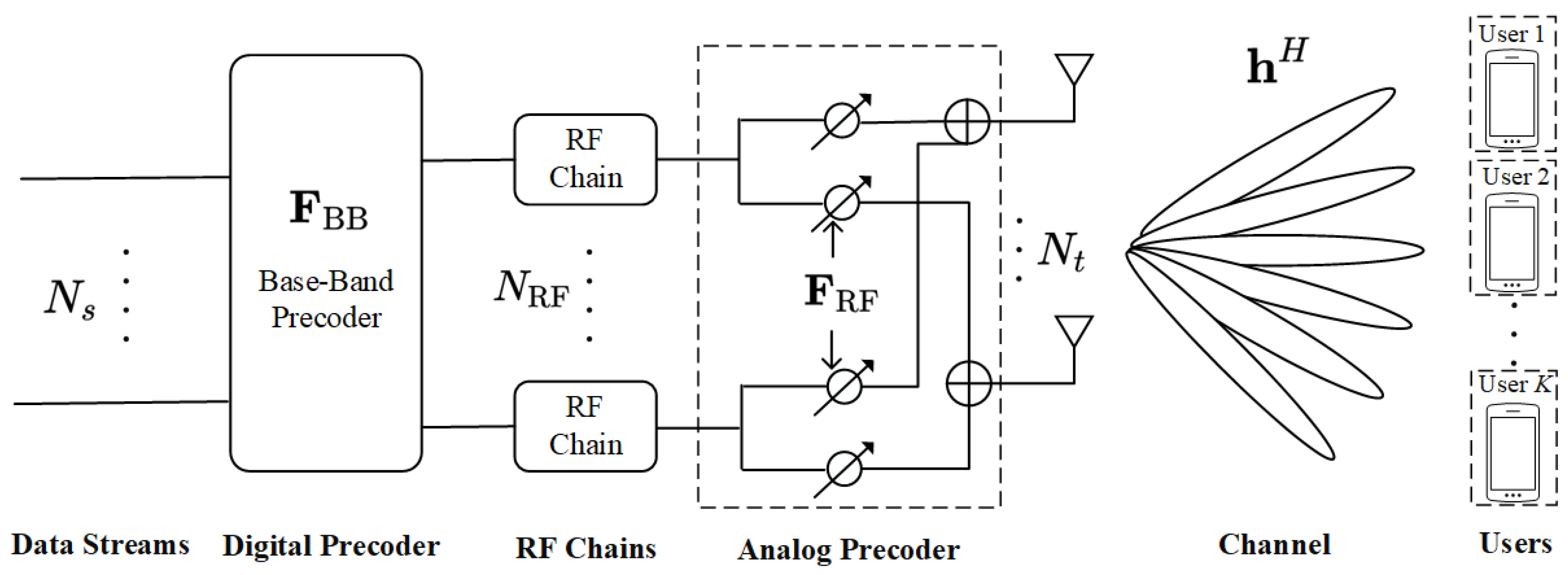


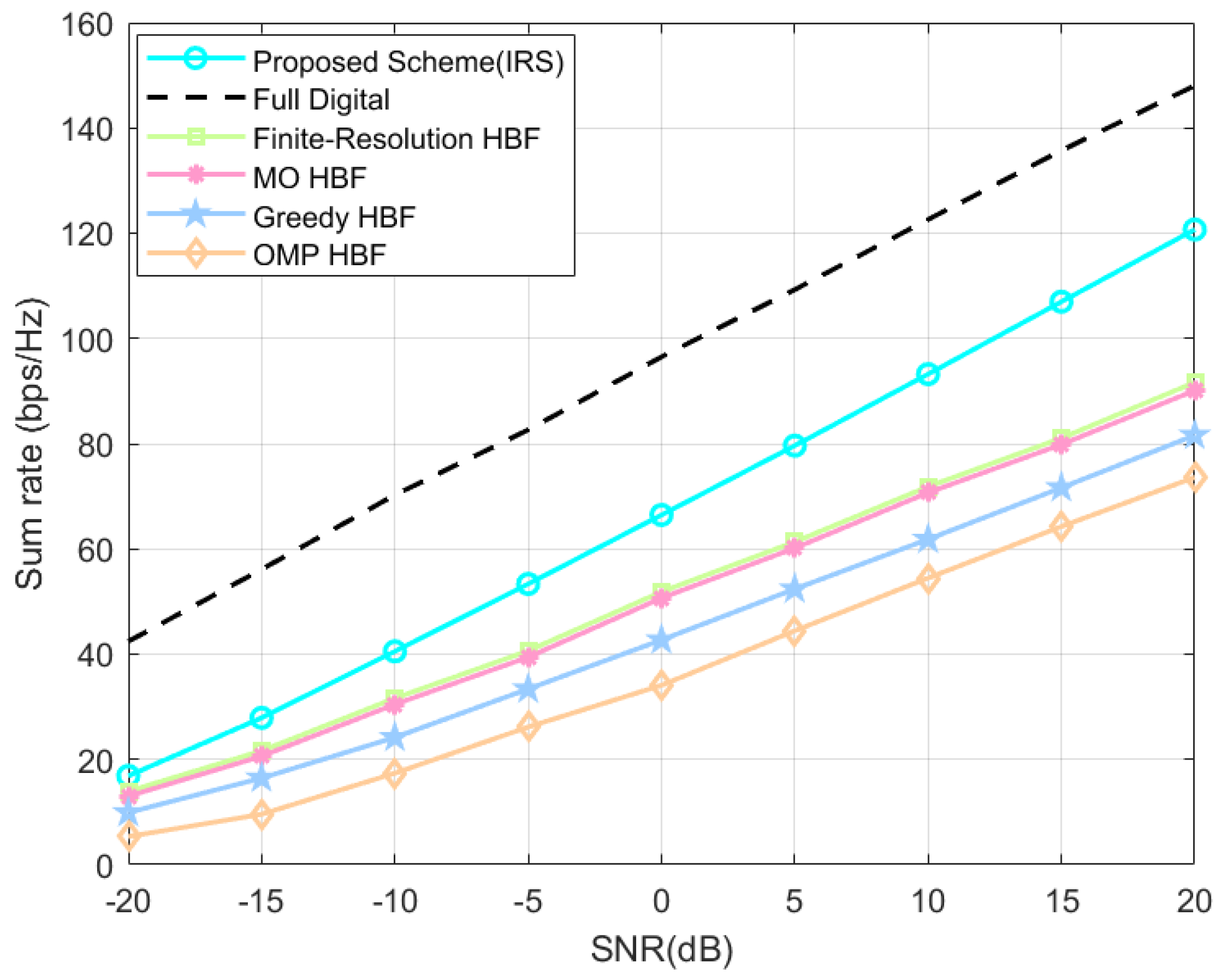
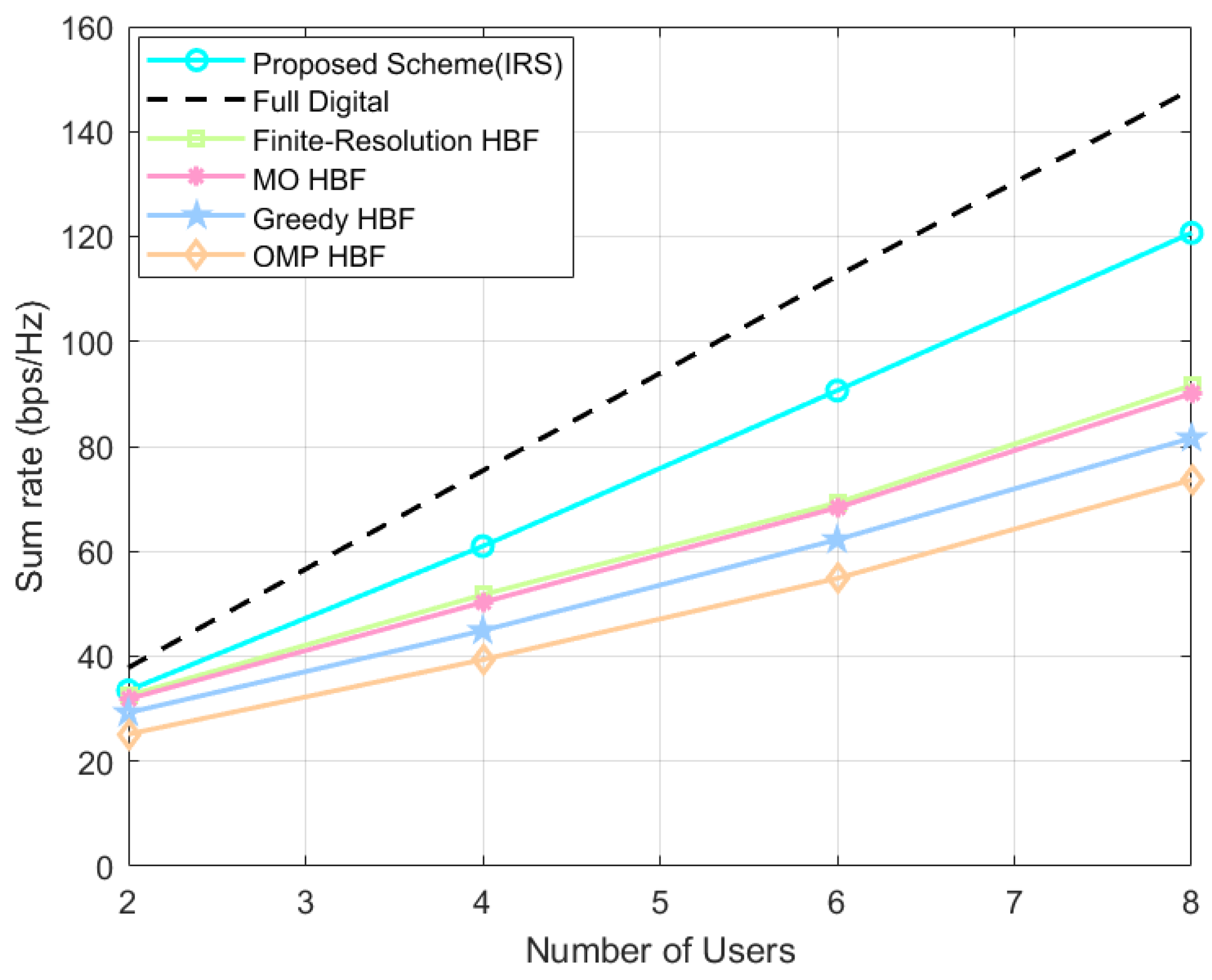
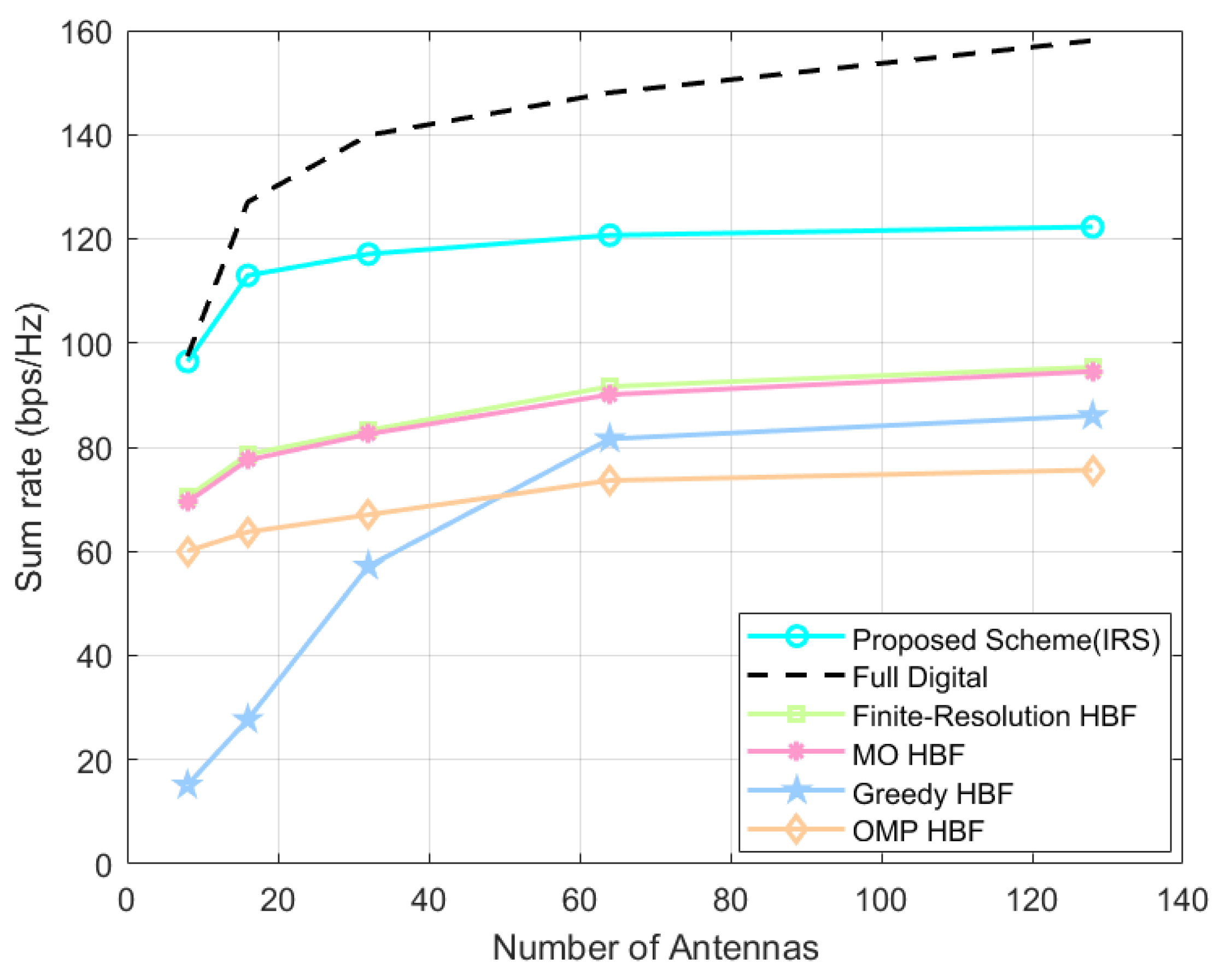



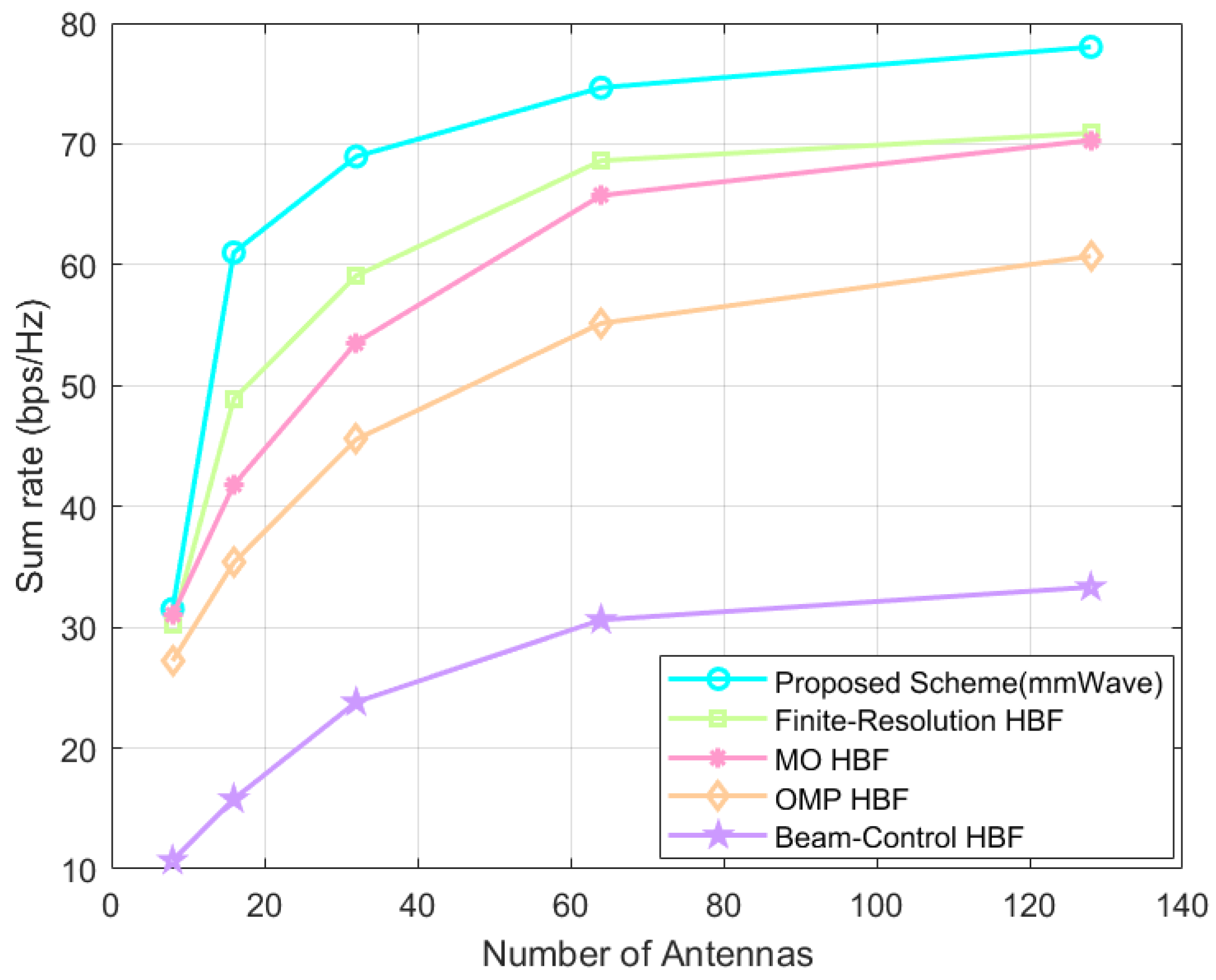
Disclaimer/Publisher’s Note: The statements, opinions and data contained in all publications are solely those of the individual author(s) and contributor(s) and not of MDPI and/or the editor(s). MDPI and/or the editor(s) disclaim responsibility for any injury to people or property resulting from any ideas, methods, instructions or products referred to in the content. |
© 2024 by the authors. Licensee MDPI, Basel, Switzerland. This article is an open access article distributed under the terms and conditions of the Creative Commons Attribution (CC BY) license (https://creativecommons.org/licenses/by/4.0/).
Share and Cite
Huang, Z.; Yang, L.; Tan, W.; Wang, H. Adaptable Hybrid Beamforming with Subset Optimization Algorithm for Multi-User Massive MIMO Systems. Sensors 2024, 24, 4189. https://doi.org/10.3390/s24134189
Huang Z, Yang L, Tan W, Wang H. Adaptable Hybrid Beamforming with Subset Optimization Algorithm for Multi-User Massive MIMO Systems. Sensors. 2024; 24(13):4189. https://doi.org/10.3390/s24134189
Chicago/Turabian StyleHuang, Ziyang, Longcheng Yang, Weiqiang Tan, and Han Wang. 2024. "Adaptable Hybrid Beamforming with Subset Optimization Algorithm for Multi-User Massive MIMO Systems" Sensors 24, no. 13: 4189. https://doi.org/10.3390/s24134189





